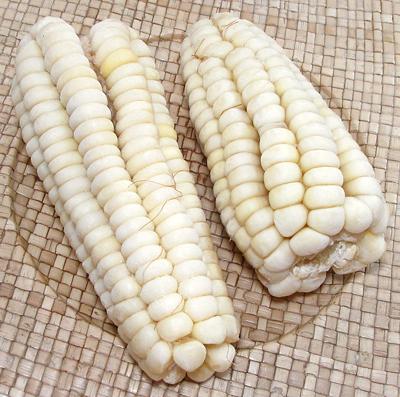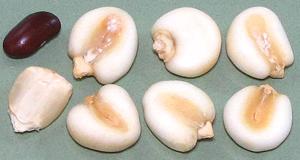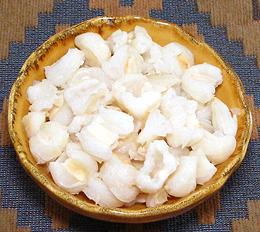Giant White Corn
 [Choclo (Elote) Peruano Gigante del Cusco; Cacahuazintle (Mexican
variety) | Maiz Pelado Blanco, Mote Pelado, Maiz Para
Pozole; Zea mays]
[Choclo (Elote) Peruano Gigante del Cusco; Cacahuazintle (Mexican
variety) | Maiz Pelado Blanco, Mote Pelado, Maiz Para
Pozole; Zea mays]
This corn has been grown in Peru for 7000 years or so, and is popular
from southern Mexico to Chile. The photo specimens (Choclo Entero - "on
the cob") were purchased frozen from a large market in Los Angeles
(Burbank) that specializes in Mexican, Central American and South
American foods. The larger was 7 inches long, 2-3/4 inches in diameter
and weighed 13-1/8 ounces, with kernels about 3/4 inch across. The
Mexican Cacahuazintle is a little smaller. The names after the "|" are
"peeled" (Hominy), for use in Tamales, Pozole soup and the like. This
is traditionally done by boiling the kernels in a solution of water and
lye, calcium hydroxide or another strong caustic, then rubbing off the
peels. This also has the effect of greatly increasing availability of
niacin (vitamin B3) - untreated corn has none in an available form.
This process is called Nixtamalization.
Be Aware: modern industrial processes can peel corn without use of
caustics, but this does not convert the niacin. If it matters to you,
look for indications on packages that mention lye, lime, sodium
hydroxide, calcium hydroxide or "traditional processing".
More on Corn.
 Buying: Giant White Corn can be found in markets
serving a Latin American community, though it sometimes takes some
looking. The photo specimens, on the cob and peeled, came from a large
Los Angeles (Burbank) market specializing in Mexican, Central American
and South American foods. The kernel to the left under the kidney bean
is a large unpeeled regular dry white corn kernel, this is not
what you want. The peeled kernels were imported from Peru in a plastic
bag, Goya and a couple other companies also sell the peeled product in
14 ounce plastic bags. It is the preferred corn for the important
Mexican soup/stew Pozole.
Buying: Giant White Corn can be found in markets
serving a Latin American community, though it sometimes takes some
looking. The photo specimens, on the cob and peeled, came from a large
Los Angeles (Burbank) market specializing in Mexican, Central American
and South American foods. The kernel to the left under the kidney bean
is a large unpeeled regular dry white corn kernel, this is not
what you want. The peeled kernels were imported from Peru in a plastic
bag, Goya and a couple other companies also sell the peeled product in
14 ounce plastic bags. It is the preferred corn for the important
Mexican soup/stew Pozole.
Storing: Sealed in a 2-mil thick plastic bag or other
insect-proof container, and stored in a cool place, the dried corn will
last a year or more.
 Cooking: For the peeled kernels - Soak overnight.
Pinch off the dark "eye" of each kernel (the point where it attached to
the cob). This is tedious, but it will allow the kernels to "open like
a flower" during cooking.
Cooking: For the peeled kernels - Soak overnight.
Pinch off the dark "eye" of each kernel (the point where it attached to
the cob). This is tedious, but it will allow the kernels to "open like
a flower" during cooking.
Cooking time suggested by Diana Kennedy is 3 hours, but I find 2-1/2
hours to be reasonably acceptable for most recipes, but for salads or
other recipes that will have no additional cooking, go for 3 hours.
There will always be some fiber, no matter how long you cook it.
The photo to the left shows corn after cooking 3 hours. Some kernels
did not "open like a flower", but they are tender enough to be eaten.
IF you need to peel your own corn kernels, here is my adaption
of Diana Kennedy's method.
- Place 1 pound of dried kernels in a pot and soak at least overnight.
- Change the water and bring the corn to a boil.
- Dilute about one large teaspoon of Unslaked Lime (pickling lime) in
a little cold water. Pour into the pot through a strainer (lye may
also be used).
- Boil the corn for about 10 minutes. Cover and let it soak for 30
minutes.
- Wash the corn well in several changes of water, rubbing it between
your hands to remove the skins.
- Pinch off the dark "eye" from each kernel so the corn will "open
like a flower".
- Cook the corn until the kernels "open like a flower". This will
take simmering for 1 to 3 hours depending on the corn, its age and
previous processing.
- The corn is now "recipe ready".
gr_crngwz 170806 - www.clovegarden.com
©Andrew Grygus - agryg@clovegarden.com - Photos on this
page not otherwise credited are © cg1 -
Linking to and non-commercial use of this page permitted
 Buying: Giant White Corn can be found in markets
serving a Latin American community, though it sometimes takes some
looking. The photo specimens, on the cob and peeled, came from a large
Los Angeles (Burbank) market specializing in Mexican, Central American
and South American foods. The kernel to the left under the kidney bean
is a large unpeeled regular dry white corn kernel, this is not
what you want. The peeled kernels were imported from Peru in a plastic
bag, Goya and a couple other companies also sell the peeled product in
14 ounce plastic bags. It is the preferred corn for the important
Mexican soup/stew Pozole.
Buying: Giant White Corn can be found in markets
serving a Latin American community, though it sometimes takes some
looking. The photo specimens, on the cob and peeled, came from a large
Los Angeles (Burbank) market specializing in Mexican, Central American
and South American foods. The kernel to the left under the kidney bean
is a large unpeeled regular dry white corn kernel, this is not
what you want. The peeled kernels were imported from Peru in a plastic
bag, Goya and a couple other companies also sell the peeled product in
14 ounce plastic bags. It is the preferred corn for the important
Mexican soup/stew Pozole. [Choclo (Elote) Peruano Gigante del Cusco; Cacahuazintle (Mexican
variety) | Maiz Pelado Blanco, Mote Pelado, Maiz Para
Pozole; Zea mays]
[Choclo (Elote) Peruano Gigante del Cusco; Cacahuazintle (Mexican
variety) | Maiz Pelado Blanco, Mote Pelado, Maiz Para
Pozole; Zea mays]
 Cooking: For the peeled kernels - Soak overnight.
Pinch off the dark "eye" of each kernel (the point where it attached to
the cob). This is tedious, but it will allow the kernels to "open like
a flower" during cooking.
Cooking: For the peeled kernels - Soak overnight.
Pinch off the dark "eye" of each kernel (the point where it attached to
the cob). This is tedious, but it will allow the kernels to "open like
a flower" during cooking.